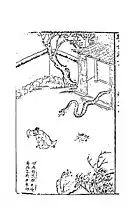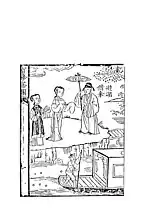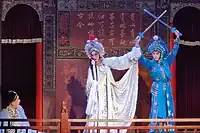| Legend of the White Snake | |||||||||||||||
|---|---|---|---|---|---|---|---|---|---|---|---|---|---|---|---|
 Image from the Summer Palace, Beijing, China, depicting the legend | |||||||||||||||
| Traditional Chinese | 白蛇傳 | ||||||||||||||
| Simplified Chinese | 白蛇传 | ||||||||||||||
| |||||||||||||||
The Legend of the White Snake is a Chinese legend centered around a romance between a man named Xu Xian and a female snake spirit named Bai Suzhen. It is counted as one of China's Four Great Folktales, the others being Lady Meng Jiang, Butterfly Lovers, and The Cowherd and the Weaver Girl.[1]
Early versions

The snake-woman motif possibly came from Indian folklore.[2] In the earliest versions the white snake was depicted as an evil demon. Over the centuries, however, the legend has evolved from a horror tale to a romance story about forbidden love.
"Li Huang"
The Tang-dynasty story collection Boyi zhi (博異志; "Vast Records of the Strange"), from the early 9th century, contains a chuanqi tale about a man named Li Huang (李黃) meeting an attractive woman clad in white (whose aunt is clothed in blue-green). After mating with the beauty at her residence, he returns home and falls ill, his body dissolving into water. His family searches for the woman and discovers that she is a giant white snake.[2]
"The Three Pagodas of West Lake"
In the Ming dynasty, some time before 1547, a collection of early huaben tales was printed by Hong Pian (洪楩); in it was "The Three Pagodas of West Lake" (西湖三塔記), likely the first work to set the legend in the Southern Song capital Lin'an Prefecture, or modern Hangzhou. In this story, a man named Xi Xuanzan (奚宣贊) meets a girl, her mother, and her grandmother; he falls in love with the mother — who is dressed in white — but the girl warns him that her mother has killed all her previous lovers. A Daoist exorcist exposes the mother as a white snake; her daughter is a black chicken and the grandmother an otter. He builds three stone pagodas in the West Lake and subjugats the creatures beneath them. Xi Xuanzan becomes a religious layman.[3]
"Madam White Is Kept Forever Under the Thunder Peak Tower"
The story "Madam White Is Kept Forever Under the Thunder Peak Tower" (白娘子永鎭雷峰塔) in Feng Menglong's influential 1624 collection Stories to Caution the World began to portray the White Snake in a sympathetic perspective.[4] Xi Xuanzan had become Xu Xuan (許宣), the Taoist exorcist had become a Buddhist monk named Fahai, and the White Snake now has a maid-servant (clothed in blue-green) named Qingqing (青青), who is a fish spirit. In this tale the White Snake tries to enrich her husband, but unwittingly turns him into a crime suspect; when he tries to leave her, she threatens him with a flood. The story ends with the righteous monk Fahai trapping the demons under the Leifeng Pagoda ("Thunder Peak Tower").[4]
 An illustration from Stories to Caution the World (1624).
An illustration from Stories to Caution the World (1624). An illustration from Leifeng Pagoda (1806).
An illustration from Leifeng Pagoda (1806). An illustration from The Righteous Demons (1869 print).
An illustration from The Righteous Demons (1869 print).
Qing dynasty texts
The Qing dynasty saw major transformations of the legend thanks to Chinese opera and quyi (storytelling performances). While Huang Tubi (黃圖珌)'s 1738 chuanqi play Leifeng Pagoda is considered similar to Feng Menglong's version, a major shift seemed to have occurred in texts from the late eighteenth and early nineteenth century. Three long- or medium-length works from this period are: Fang Chengpei's (方成培) chuanqi play Leifeng Pagoda (1777); a thirteen-chapter novel (also Leifeng Pagoda, 1806) by Yushan Zhuren (玉山主人, "Master of the Jade Mountain"), and The Righteous Demons (義妖傳, preface dated 1809), a transcribed tanci text by Chen Yuqian (陳遇乾). In all of them, White Snake is presented as endearing and devoted; while Fahai's portrayal is more negative.[5]


.jpg.webp)
.jpg.webp)

Basic story
The following is one version from Chinese opera:[6]
A white snake and a blue-green snake from Mount Emei transform themselves into two young women called Bai Suzhen and Xiaoqing, respectively. They become best friends and travel to Lin'an Prefecture (or Hangzhou), where they meet a young man named Xu Xian on a ferry-boat in West Lake. Xu Xian lends them his umbrella because it is raining. Xu Xian and Bai Suzhen fall in love instantly and are eventually married. They open a medicine shop.
Fahai, the abbot of Jinshan Temple in Zhenjiang, approaches Xu Xian and tells him that his wife is a snake. Xu Xian brushes him off, so Fahai tells him that he should have her drink realgar wine during the Dragon Boat Festival. Bai Suzhen unsuspectingly drinks the wine and reveals her true form as a large white snake. Xu Xian dies of shock after seeing that his wife is not human.
Bai Suzhen travels to Kunlun, where she braves danger to steal a magical herb guarded by disciples of the Old Man of the South Pole. The herb restores Xu Xian to life.
After coming back to life, Xu Xian is still fearful of his wife. He travels alone to Jinshan Temple, where Fahai imprisons him, telling him that he must live in the temple in order to save himself from the snake demons. Bai Suzhen and Xiaoqing fight with Fahai to rescue Xu Xian. During the battle, Fahai calls on guardian deities like Skanda and Sangharama to help him. Bai Suzhen uses her powers to flood the temple, causing collateral damage in the process. However, her powers are limited because she is already pregnant with Xu Xian's child, so she fails to save her husband. Xiaoqing helps her escape back to Hangzhou.
Meanwhile, Xu Xian realizes that his wife's love for him is genuine and that he no longer cares if she is a snake. He manages to escape after persuading a sympathetic young monk to release him. When he reunites with his battered wife on Broken Bridge, where they first met, Xiaoqing is so furious at him that she intends to kill him, but Bai Suzhen stops her. Xu Xian expresses his regret, and both Bai Suzhen and Xiaoqing forgive him, Xiaoqing more reluctantly.
Bai Suzhen gives birth to their son, Xu Mengjiao (in some versions Xu Shilin). Fahai tracks them down, defeats Bai Suzhen and imprisons her under Leifeng Pagoda, despite pleadings from Xu Xian. Xiaoqing flees, vowing vengeance.
Subplots and spin-offs
Prequel
Lü Dongbin, one of the Eight Immortals, disguises himself as a tangyuan vendor at the Broken Bridge. A boy called Xu Xian buys some tangyuan from Lü Dongbin without knowing that they are actually immortality pills. After eating them, he does not feel hungry for the next three days so he goes back to ask the vendor why. Lü Dongbin laughs and carries Xu Xian to the bridge, where he flips him upside-down and causes him to vomit the tangyuan into the lake. In the lake dwells a white snake spirit who has been practicing Taoist magical arts. She eats the pills and gains 500 years' worth of magical powers. She, therefore, feels grateful to Xu Xian, and their fates become intertwined. There is another terrapin (or tortoise) spirit also training in the lake who did not manage to consume any of the pills; he is very jealous of the white snake. One day, the white snake sees a beggar on the bridge who has caught a green snake and wants to dig out the snake's gall and sell it. The white snake transforms into a woman and buys the green snake from the beggar, thus saving the green snake's life. The green snake is grateful to the white snake and she regards the white snake as an elder sister. In the meantime, the terrapin spirit has accumulated enough powers to take on human form, so he transforms into a Buddhist monk called Fahai.
Sequel
Twenty years after his mother is buried under the pagoda, Xu Mengjiao earns the position of zhuangyuan (top scholar) in the imperial examination and returns home in glory to visit his parents. At the same time, Xiaoqing, who had spent the intervening years refining her powers, goes to the Jinshan Temple to confront Fahai and defeats him. Bai Suzhen is freed from Leifeng Pagoda and reunited with her husband and son, while Fahai flees.
In a version Fahai hides inside the stomach of a crab. There is a saying that a crab's internal fat is orange because it resembles the color of Fahai's kasaya.
Modifications and alternate versions
The legend has been presented in a number of major Chinese operas, films, and television series.
The white snake was simply known as the "White Lady" or "White Maiden" (白娘子) in the original tale in Feng Menglong's Stories to Caution the World. The name "Bai Suzhen" was created in a later era.
Some adaptations of the legend in theater, film, television and other media have made extensive modifications to the original story, including the following:
- The green snake (Xiaoqing) is portrayed as a treacherous antagonist who betrays the white snake, as opposed to the traditional depiction of her as the white snake's close friend and confidant.
- Alternatively, the green snake (Xiaoqing) is less evolved, less well-trained compared to the white snake (Bai Suzhen), and thus less cognisant of what it means to be human. She is more animalistic and therefore sometimes at odds with Bai Suzhen, thus explaining their differences both in character and actions.
- Fahai is portrayed in a more sympathetic light as opposed to the traditional depiction of him as a vindictive and jealous villain: rigid and authoritarian, yet well-intentioned. His background story is also different in some adaptations.
- Bai Suzhen is freed from Leifeng Pagoda because her son's filial piety moved Heaven.
- A retcon or revisionist version of the story relates that Xu Xian and Bai Suzhen were actually immortals who fell in love and were banished from Heaven because celestial laws forbade their romance. They are reincarnated as a male human and a female white snake spirit respectively and their story begins.
Adaptations

See also
Notes
- ↑ Idema (2012), p. 26.
- 1 2 Chen, Dong (2019). Dialogues Between Two Worlds: Prophecy, Resurrection and the Imagination of the Otherworld (PDF) (Ph.D. thesis). Scuola Normale Superiore. Retrieved January 6, 2024.
- ↑ Wang, Eugene Y. (2003). "Tope and Topos: The Leifeng Pagoda and the Discourse of the Demonic". In Zeitlin, Judith T.; Liu, Lydia H.; Widmer, Ellen (eds.). Writing and Materiality in China: Essays in Honor of Patrick Hanan (PDF). Harvard University Asia Center. pp. 496–497.
- 1 2 Wang, Yue Cathy (2023). Snake Sisters and Ghost Daughters: Feminist Adaptations of Traditional Tales in Chinese Fantasy. Wayne State University Press.
- ↑ Luo, Liang (2021). The Global White Snake. University of Michigan Press. p. 13-14.
- ↑ Shepard, Aaron. Lady White Snake: A Tale from Chinese Opera. Illustrated by Song Nan Zhang. Pan Asian Publications.
References and further reading
- Idema, Wilt L. (2009). The White Snake and Her Son: A Translation of the Precious Scroll of Thunder Peak with Related Texts. Hackett Publishing. ISBN 9781603843751.
- —— (2012). "Old Tales for New Times: Some Comments on the Cultural Translation of China's Four Great Folktales in the Twentieth Century 二十世紀中國四大民間故事的文化翻譯" (PDF). Taiwan Journal of East Asian Studies. 9 (1): 25–46. Archived from the original (PDF) on October 6, 2014.
- Mao, Xian (2013). Cowherd and Weaver and other most popular love legends in China. eBook: Kindle Direct Publishing.
External links
![]() Media related to Legend of the White Snake at Wikimedia Commons
Media related to Legend of the White Snake at Wikimedia Commons
- Fashion/art film starring Daphne Guinness, directed by Indrani.
- Legend of White Snake – Stage Performance from Penang, Malaysia
- Stories to Caution the World in Google Books
- Lady White Snake
- Oregon Shakespeare Festival, 2012 production
- White snake in dream meaning and interpretation at snake dream meaning.